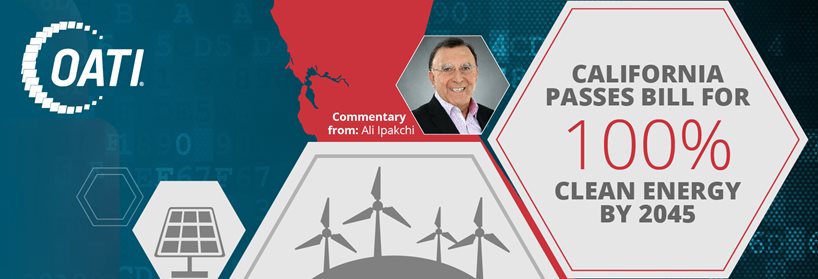Home » Blog » Grid Modernization » California Strives for 100 Percent Clean Energy
California Strives for 100 Percent Clean Energy
California governor Jerry Brown recently signed a bill (SB 100) into law, which strives to achieve 100 percent clean electricity. By 2045, California aims to power its population with only zero-carbon emission sources, as well as create a more resilient and decentralized power system.
According to the California Energy Commission’s (CEC) Tracking Progress – Renewable Energy report, California’s ambitious Renewables Portfolio Standard (RPS) required the state’s retail electric energy to be 33 percent delivered from renewable sources by 2020 and 50 percent by 2030. The state has been well on its way to meeting these targets, as evident by a CEC estimate that, in 2017, 32 percent of retail electricity sales were derived from renewable energy resources. The recently passed SB 100 modifies the RPS objective to 50 percent renewable energy by 2026 and 60 percent by 2030.
Increasingly, California has worked to further its distributed renewable capacity. As noted by the report, over 11,700 MW of distributed generation capacity, including 6,700 MW of behind-the-meter solar, was operating in the state by the end of 2017.
The CEC’s Tracking Progress – Energy Storage report found that California investor-owned utilities (IOUs) are in line to surpass the California Public Utilities Commission (CPUC) requirement of over 1,300 MW of energy storage by 2020. Out of the near 1,500 MW already or working to be approved, IOUs have procured 606.2 MW on the distribution or customer side. In addition, in support of California’s target for five million Zero Emission Vehicles by 2030, the CPUC recently approved $738 million to support the electric utilities’ transportation electrification projects.
According to OATI Executive Vice President of Smart Grid and Green Power Dr. Ali Ipakchi, initiatives similar to those in California are being rolled out in a number of European and Asian countries. For example, the EU currently has a goal for 32 percent of its energy consumption to be renewable energy by 2030. According to the International Energy Agency (IEA), China has made a strong move towards clean energy by becoming a leader in the implementation of solar photovoltaic (PV) systems and investment in electric vehicles (EVs).
The Impact of Distributed Energy Resources
Distributed energy resources, if managed properly, can deliver significant economic and reliability values to power systems operations. Utilizing renewable generation and energy storage close to loads improves system resiliency and assists in reducing greenhouse gas (GHG) emissions. It also decreases transmission and distribution (T&D) losses and capital and operational expenditures. Due to the declining costs of solar PV — as well as its grid parity in many regions — and battery storage, the industry is rapidly expanding distributed and utility-scale PV and battery projects.
However, unmanaged distributed PV generation could negatively affect distribution system reliability through voltage violations, excessive phase imbalances, and reverse power flows. The intermittency of solar generation could also create problems with supply and demand balancing and forecasting; the electrification of transportation further aggravates the situation. In addition, inverter-based generation’s insufficiency with inertia and dispatchability creates power system stability issues. Coupling PV generation with storage could dampen some adverse impacts, though leaving it unmanaged will cause challenges to remain.
Nevertheless, the electric power industry is moving into an era of operating with distributed and centralized generation and storage resources — often with intermittent fuel sources — that are environmentally-compliant. This means new tools are needed to forecast, schedule and dispatch, and control these resources.
Aggregation of end-use customer-owned distributed energy resources (DERs) into virtual power plants (VPPs) — as well as a supply of grid services from these VPPs — in support of distribution and bulk power operation will become standard business practice. For example, the recent update of the Institute of Electrical and Electronics Engineers (IEEE) interconnection standards now enables inverter-based resources to provide various grid services, such as frequency response and Volt/VAR Control (VVC), in a manner similar to bulk generation resources.
Dr. Ipakchi called attention to OATI’s Distributed Energy Resource Management System (DERMS) solution and Internet of Things (IoT) SCADA module, which offer utilities a comprehensive set of capabilities to address emerging electric power industry needs. This includes managing a distribution grid with a variety of DERs, assessing the impact of DERs on phase loading and voltage conditions, forecasting, scheduling and dispatch, and controlling VPPs to supply grid services. Our solution provides situational awareness, ensures end-to-end security, and increases end-use customer satisfaction by providing service flexibility, lower net cost, and higher service reliability. Interested in learning more? Please contact sales@oati.net.
- October 9, 2018
